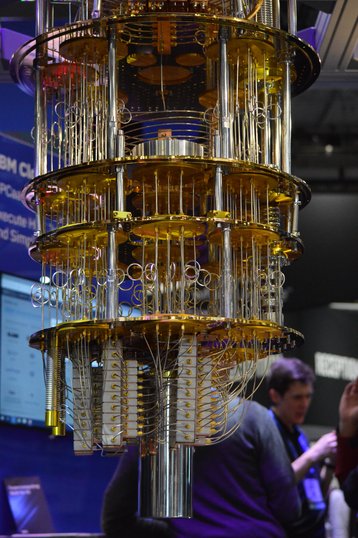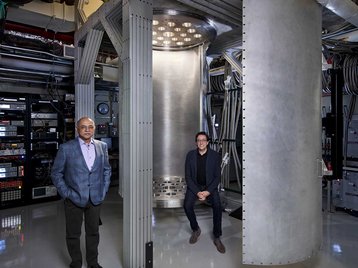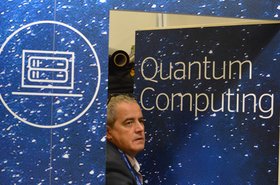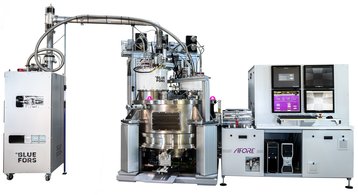As most of the cooling industry braces for ever-denser racks and debates how to cool 1000W processors, there is one sector struggling to handle chips that consume barely any power.
"On our quantum chip, power consumption is very, very low," Intel's Jim Clarke told DCD.
"We don't measure it in terms of watts, we measure it in terms of how much does our system warm up during processing,” the company’s director of quantum hardware explained. That’s because even small temperature increases can render the entire system unworkable, Clarke said. "Typically, we are trying to avoid a warm up of even 10 millikelvin."
For the superconducting quantum computers under development by companies like Google, IBM, and Rigetti, or the silicon spin qubit systems at Intel, the enemy is noise.
This feature appeared in the December Cooling Supplement. Read it for free today.
Keeping things cool
To keep systems in a quantum state, designers have to minimize the risk of anything disrupting the fragile position. The slightest temperature increase can mean that atoms and molecules move around too much, potentially causing a quantum bit (qubit)'s voltage to spike, and flip from one quantum state to another.
“Quantum chips have to operate at very low temperatures in order to maintain the quantum information,” Clarke said. To do this, Intel uses cryogen-free dilution refrigerator systems from specialist Blufors.
The refrigerator features several stages, getting colder as you go down - all the way "down to temperatures just a fraction of a degree above absolute zero - that is really cold. In fact, it's 250 times colder than deep space,” Clarke said. “We use a mixture of helium isotopes as our refrigerant to get down to these very cold temperatures, in the tens of millikelvin.”
While the refrigeration system can bring temperatures down to extremes, it can't remove heat very quickly - so if you have a chip in there that's creating a lot of heat, you're going to have a problem.
"You're probably familiar with the power dissipation of an FPGA," Clarke said. "This would overwhelm the refrigeration cooling capacity. At the lowest level of a fridge, you typically have about a milliwatt of cooling power. At the four Kelvin stage [higher up in the fridge], you have a few watts."
Future fridge designs are expected to improve things, but it's unlikely to massively increase the temperature envelope. "That imposes limitations on the power dissipation of your control chips."
Beyond the quantum chip itself, quantum systems need other hardware to make them fully-fledged computers. Some of that can be handled outside the fridge, with most quantum computers paired with a few racks of conventional HPC servers. But other parts, particularly the control chip, need to be inside the fridge itself - which means yet another thing that needs to work under extreme conditions, while not giving out too much energy itself.
"Controlling the quantum chip is actually pretty difficult, and that's what we do with Horse Ridge," Clarke said. Its second-generation Horse Ridge II is a CMOS chip, "with more than 100 million transistors, produced on our 22-nanometer node."
The hardware, revealed this month, is verified at operating at 4 Kelvin, but the company hopes to push that in the years ahead. "Going forward, you would probably focus not only on additional capability, but on additional power optimization of Horse Ridge inside the fridge," Clarke said.
"And you would probably also focus on improving the cooling capacity of the fridge, which our external suppliers and the quantum ecosystem is working on."
But Intel has taken a slightly different route than some of its quantum competitors. Like Google and IBM, it has worked on superconducting qubit systems, including its 49-qubit Tangle Lake processor, but in recent years it has started to shift to researching spin qubits with partner QuTech.
A debate rages about which approach is best, but one huge advantage of spin qubits, which more closely resemble existing semiconductor components, is that they are expected to have a 'much' higher operating temperature. Instead of 20 millikelvins, they can run at around one degree. That might not sound like a huge difference, but “believe it or not, it makes things tremendously easier.”
Spin qubits are far smaller than superconducting ones, with a square millimeter theoretically having enough room for up to a billion spin qubits. But we're a long way from that, and currently efforts to build more powerful quantum systems will require bigger fridges.
"I think the form factor of the fridge will be bigger than it is now," Clarke said. "Right now, it's about the size of a keg of beer. When I think about what it would take to get to a million qubits, you still aren't at a point where you're worried about the form factor of the fridge or the system - it's not going to be a similar size as a typical supercomputer, with rows, rows, and rows of racks.
“It may, in the end, look like one of the gas cylinders you might see out of a hospital, that sort of size, but that's still I think, quite manageable from a form factor in the data center.”
Everything is better with lasers
Others think they could do better, arguing that we could eschew giant fridges entirely. "We run at room temperature," Peter Chapman, the CEO of quantum computing startup IonQ, said.
"Yeah, there's cooling, but it's laser cooling, and it's on individual atoms. How much energy does it take to cool 40 atoms?"
Instead of a whole rig to cool a quantum chip, IonQ posits that you could just cool the atoms you need to be in a quantum state. In laser Doppler cooling, atoms are surrounded by lasers which are tuned to a frequency slightly below an electronic transition in the atom.
Should an atom move towards one of the lasers, the light is blue-shifted to where the atom can absorb the light, slowing its motion. The atom then emits a photon in a random direction.
For trapped ion quantum computers - which are also being developed by companies like Honeywell - to work, ions (a charged atom or molecule) need to be approximately stationary, operating at a temperature of about a microkelvin.
To do all this at the atomic level sounds immensely complex, but Chapman’s company is able to take advantage of decades of research from an adjacent industry. “The secret is, what we're doing is based on atomic clocks - it’s the same exact technology. We've managed to push an atomic clock onto a chip, and that's used by many industries.”
The company in October unveiled a 32 qubit chip. According to one benchmark, that is the most powerful quantum computer ever made - but quantum computing measurement is a whole other feature entirely.
Late last year, the company opened its very own data center to test out its three main quantum systems, and offer remote access to researchers. By 2023, it hopes to be in other data centers - at the rack level.
"Our goal is to get it to a rack-mounted system," Chapman said. He pointed out that the company’s approach vastly differs from the superconducting system used by IBM (which, according to a different benchmark, claims to be the world’s most powerful quantum computer).
“IBM said that they could no longer buy a dilution refrigerator large enough,” Chapman said. “So they had to go start building their own - they released a picture a couple of weeks ago, and it looked like a kind of a missile silo. The exact same thing at IonQ is the size of a half-dollar.
“And they acknowledge that you would have to get to hundreds of those things, so for them, you would have to get to be the size of a football field. All at damn close to zero degrees. There's probably not enough helium in the world to do those things.”
Laser cooling wouldn’t work for IBM or Intel’s approaches, Clarke said. “You're not only worried about what temperature you can get, but also cooling power. It’s a question of how many watts of power can you remove from the system and still maintain that temperature.
“And so with Doppler cooling, the question to ask is not what temperature you can get to but how much cooling power you have. I think that for these systems, you're primarily looking at the helium dilution refrigeration technique.”
As for which system approach is better, well, that’s a rather contentious matter among academic and corporate circles, with the winner potentially netting billions and changing the face of computing.
But for Amazon Web Services, the dominant cloud provider, it doesn’t mind that there are so many different approaches. That just means more options it can sell.
Quantum computing comes to the cloud
"There's a real open field in the industry, in terms of which of these machines will be most suitable to build a long term powerful device," said Richard Moulds, the general manager of AWS' quantum computing service Braket.
"There are a dozen or so companies that are building quantum machines, essentially competing with different technologies to prove that their particular chosen path is superior to another. In the end, it might turn out that a single technology for building a quantum computer doesn't necessarily win the race, it might turn out there are multiple different technologies that are each well suited to different applications."
With Braket, the company offers cloud access to several of the approaches, including Rigetti (gate-based superconducting qubits), D-Wave (quantum annealing, operating at 15 millikelvin), and IonQ.
Signs point to Amazon also developing its own system, something it would not comment on. It's also worth noting that Amazon invested in IonQ (along with Google Ventures), and Peter Chapman was previously the head of Amazon Prime.
"Braket was the first time that an IonQ machine was publicly accessible," Moulds said. "And we expect to increase the range of technologies that will be available to the Braket service over time - our goal is to make all the different ways you can build a quantum computer available to our customers."
Each approach will have different cooling needs, AWS director of quantum computing Simone Severini told DCD. "For example, light can be used for quantum computing. Take a photon, it is a type of qubit because you can prepare it in two distinguishable states by polarizing the photon. And they of course are around us, so they exist in an environment that doesn't require extremely cold temperatures."
This technique was recently used by Chinese state-backed researchers to develop a highly-specialized system capable of achieving quantum supremacy: That is, to pull off a calculation no conventional computer could do. The group claimed it was 10 billion times faster than Google's system, which achieved supremacy last year, but both are only useful for one specific calculation.
"So in general, the thing to keep in mind is that there are many different approaches to build quantum computers," Severini said. "Some of these approaches will require a cryogenic environment, some of these will not. All these approaches are equally interesting, and all these approaches are currently subject of research."
Whether cryogenic cooling proves to be the de facto approach to quantum computing or not, Clarke notes that there are other benefits to such low temperatures. “Even our conventional transistors have quantum effects,” he explained. “And by studying something at low temperature, you remove a lot of the variability or noise and you can really start answering fundamental questions about your device.”
The company built a 'cryoprober' with Bluefors and Afore, a fast electrical characterization tool that can operate in the quantum regime at about a kelvin. That means the company can probe how its systems - be they quantum chips, controllers, or other hardware - operate at extreme temperatures.
Release the probe
“It allows us to get massive amounts of information in a very short time, we think by 100× or 1000×,” Clarke said. “It's gonna take something like that to really accelerate quantum computing, but it will serve a purpose as we try to understand the performance of our more conventional devices.”
Advances in extreme cooling technology funded by the quantum computing industry could also open the door for another ‘it’ll-be-big-in-10-years’ technology: superconducting supercomputers. First posited by electrical engineer Dudley Buck, the idea to take advantage of the lack of electrical resistance exhibited by superconducting materials at near-zero has been a goal of the National Security Agency for decades.
But, despite hundreds of millions being sunk into various public and top-secret projects, efforts have struggled.
“There’s the idea of using superconducting logic,” Clarke said. “So it looks something different than a typical transistor, but because of superconducting logic, the question would be, can you essentially have a device that has almost no power dissipation?”
Low temperatures can offer benefits even to traditional computing systems, Clarke said. "If you take a transistor, and you operate it at very low temperature, perhaps with some process optimization, it's probably either 2× faster or 2× power efficient.” Currently the effort it takes to get that improvement isn’t worth it, but some argue that once costs come down it could make sense.
“I think that the jury is still out on that,” Clarke said, adding that the cryoprober could help that jury make a decision. “We built this device for this tool for quantum computing, but it will serve a purpose as we try to understand the performance of our more conventional devices.”
As for the quantum computer itself, it may take up a large amount of space, and it may require expensive and complex cooling systems. That’s okay, Clarke said: "If it provides you something that no computer on Earth can provide you, then it's worth the space.”




